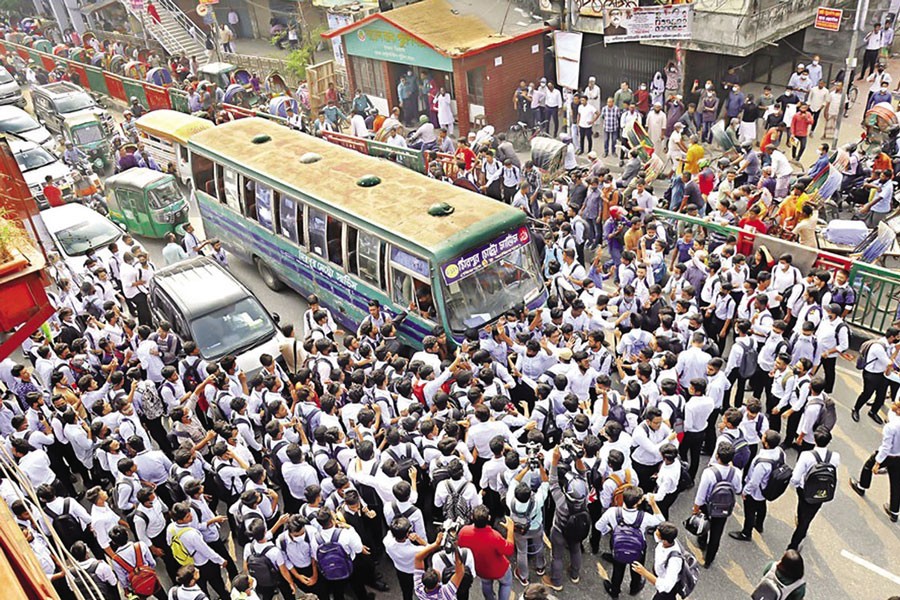Just a few weeks back on November 24, a student of Notre Dame College, Nayeem Hasan was run over by a Dhaka South City Corporation garbage truck. Just the day after, another person was killed by a garbage truck operated by Dhaka North City Corporation. Not even after a week of these two accidents, an SSC exam candidate from Ekramunnesa School and College, Mainuddin was killed as a bus ran over him in Dhaka's Rampura on the night of November 29.
This caused massive outrage and triggered agitation amongst students, as they tabled a nine-point demand to push their mandate over ensuring public safety on the roads and half fare on public transports in the country.
In another instance, in 2018, a speeding bus lost control in Dhaka, killing Dia Khanam Mim and Abdul Karim Rajib, two students of Shaheed Ramiz Uddin Cantonment College, and injuring nine. This accident ignited a spark in the students and the aftermath was thousands of students protesting on the street to seek a safer street. Moreover, the students took it upon themselves to check the papers of cars on the street to ensure safe roads for everyone.
The students had their demands and ultimately the government consented, which led to the formation of the Road Transport Act 2018 and an issuing of a 17-point directive from the Prime Minister's Office. The police even started a nationwide Traffic Week to check traffic violations and increase awareness about road safety.
Although these steps were taken or promised, very few promises have been delivered. Therefore, the pictures of the streets remain almost unchanged. The Road Transport Act was enacted but many sections of the law were not enforced, and as a result, anarchy in the road transport sector prevails and the number of road accidents is increasing. Moreover, road accidents across the country saw a sharp rise over the last three years.
The recent accidents vividly portray the fact that the road accidents in Bangladesh are showing no sign of improving, even after thousands of deaths and two road safety movements by students.
As per data from the Directorate General of Health Services (DGHS), at least 64 people are killed and over 150 people are injured in road accidents every day in our country, on average. At least 38,635 people were killed in a total of 26,279 road accidents across the country between 2015 and 2020, according to Bangladesh Jatri Kalyan Samity (BJKS). So, that raises one question: were those movements all for nothing? The answer is not what people expected.
The government gave students hope and made many promises during the road safety movement in 2018. The students halted their protests back then trusting the verbal confirmation from the authorities about meeting their demands, but as soon as the movement lost momentum, the scenario in the roads went back to how it was.
During the movements, the authorities asked students to get back to their campuses and focus on studying, mentioning that the government is taking different initiatives to avert road accidents. If that were the case from the end of the authority, the question remains: Why has the number of road accidents increased since the first road safety movement? And why isn't the 17-point directive issued by the Prime Minister's Office not being implemented? Where is the enactment of the Road Transport Act?
The answers to these questions are unanswered. As such catastrophic accidents continue to occur across the country, a question pops up in the heart of every student-- was the efforts worth it during the road safety movement?
The efforts were surely worth it, as the government issued a gazette notification on December 13 regarding half fare for students in metropolitan areas where ‘City Bus Service’ is available, which came as the first tangible achievement and a major victory from these movements. However, the gazette came with five conditions that the students have deemed 'unrealistic' and demanded unconditional half fare on ‘all modes of public transport’ across the country.
The road-safety movements were not merely by the students for an ulterior motive; these movements were for people from all walks of life, for the innocent people who have lost their lives to these accidents and their aggrieved families. Although these protests are yet to be effective on a greater scale, they have surely served as a beacon of hope. A hope that the young Bangladeshis can make a change and that we have activists to direct us on the right path, in the days to come.
The writer is a student at IBA, University of Dhaka.
[email protected]


